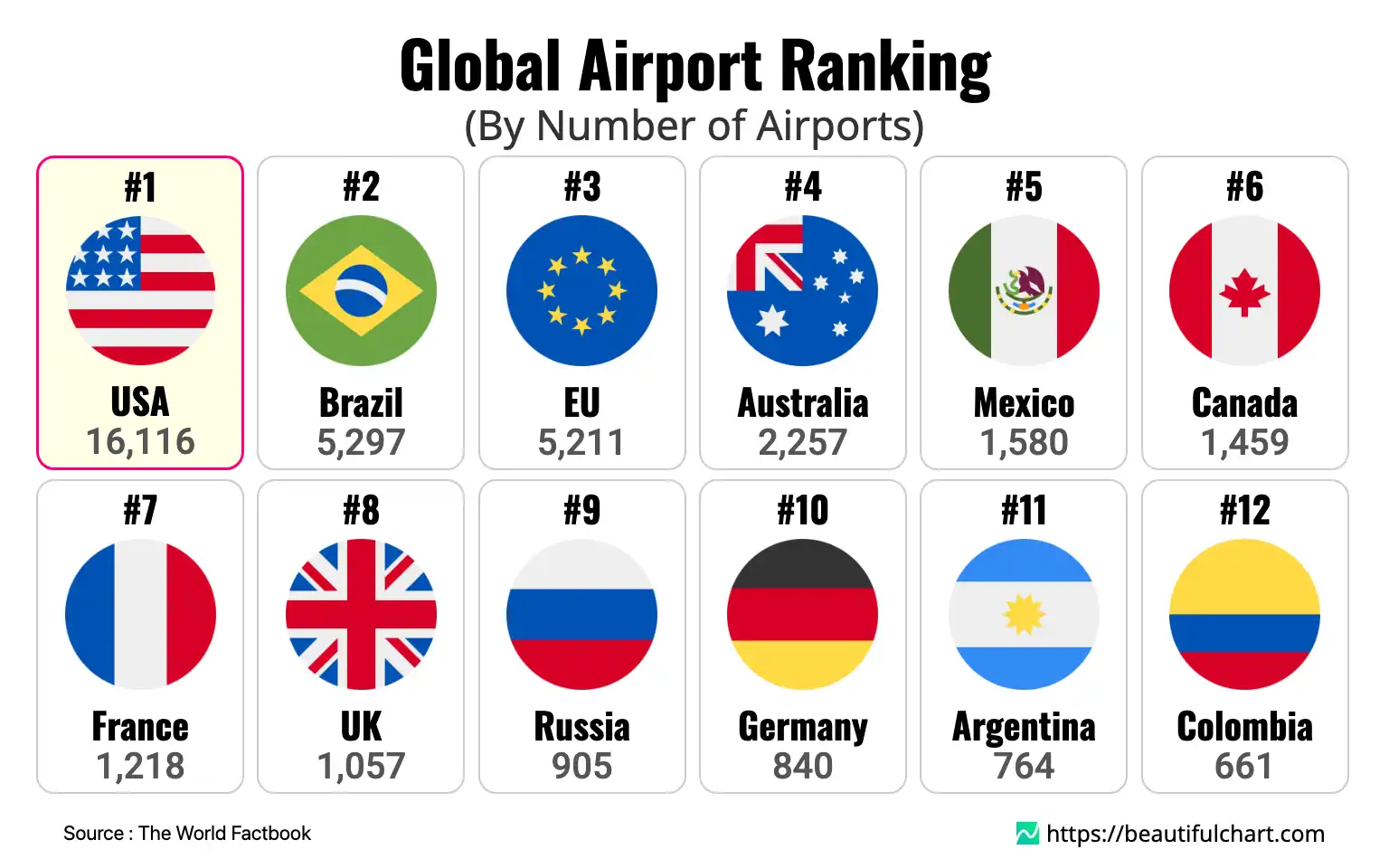The United States holds a commanding lead in aviation infrastructure, possessing over 16,000 airports, a figure that dramatically surpasses the rest of the world. Following the U.S., Brazil has the second-highest number with approximately 5,300 airports. The data highlights a significant concentration of air travel facilities in the Americas, with the European Union as a collective entity also ranking high on the list.

An airport is a facility where aircraft such as airplanes, helicopters, and blimps can take off and land. Airports typically include infrastructure such as runways, taxiways, hangars, and terminal buildings for passenger and cargo processing. They serve as critical hubs for transportation, commerce, and global connectivity.
The Unmatched Aviation Infrastructure of the United States
The sheer number of airports in the United States, exceeding 16,000, positions it as the undisputed global leader in aviation infrastructure. This extensive network is not merely a collection of large international hubs but includes a vast array of regional, local, and private airfields that form the backbone of the nation's transportation system. This dominance reflects the country's large landmass, economic prowess, and a deeply ingrained culture of air travel for both commercial and general aviation purposes. The necessity of connecting sprawling urban centers with remote rural communities has driven the development of a multi-tiered system that supports everything from international commerce to personal mobility. Major hubs like Hartsfield-Jackson Atlanta, LAX, and Chicago O'Hare are critical nodes in the global travel network, but it is the thousands of smaller airports that ensure comprehensive national connectivity.
Geographic Expanse and Airport Density
Countries with vast geographical territories naturally exhibit a higher demand for air travel, a fact clearly reflected in the rankings. Brazil, Australia, and Canada, all of which feature in the top tier, rely heavily on aviation to bridge immense distances between population centers. In Brazil, airports are vital for connecting the densely populated coastal cities with the remote interior, including the vast Amazon basin. Similarly, Australia's population is heavily concentrated along its coasts, making air travel the only practical means of traversing the expansive outback. This reliance fosters a robust network of domestic routes and airfields essential for national cohesion and economic activity. The distribution underscores a fundamental principle: where ground transportation is challenged by distance or terrain, air connectivity becomes indispensable.
European Connectivity and Global Hubs
The European Union, when considered as a single entity, ranks third, showcasing a dense and highly integrated network of airports within a relatively compact geographical area. This reflects the high level of economic and social integration among member states, where air travel facilitates business, tourism, and regional mobility. Nations like France, the United Kingdom, and Germany individually contribute significantly to this total, each hosting over a thousand airports. These countries serve as major gateways for international travel, with their primary airports functioning as critical hubs that connect continents. The concentration of facilities in Europe highlights a different model of aviation development—one based on high-density, cross-border traffic rather than purely domestic long-haul travel.
Airports in Emerging Economies
The list also reveals the growing importance of aviation in emerging economies. Mexico's high ranking is driven by its strategic location as a bridge between North and South America, a thriving tourism industry, and a growing manufacturing sector. Countries like Indonesia and China are also expanding their aviation infrastructure to support economic growth and connect their large populations. While China's current number may seem modest relative to its size and economic output, it is undergoing one of the most ambitious airport construction programs in history. This indicates a strategic shift towards enhancing air connectivity, suggesting its ranking is likely to climb in the coming years as it aims to meet the demands of a rapidly growing middle class and expanding global trade.
Key Takeaways
Global Airport Distribution
- The United States possesses a vastly larger number of airports than any other nation, highlighting its extensive aviation infrastructure.
- The Americas dominate the top of the list, with the USA, Brazil, Mexico, and Canada all ranking in the top six.
- There is a significant gap in the number of airports between the top-ranked countries and the rest of the world.
Economic and Geographic Factors
- A country's physical size is a major factor in the number of airports it has, as aviation is crucial for connecting remote regions.
- Economic development and tourism play a key role, driving the need for both international and domestic air travel facilities.
- The European Union's high collective count reflects a dense, interconnected network designed for frequent cross-border travel.
Top Ranking
#1 USA 16,116
The United States' top ranking is a testament to its massive and diverse aviation sector. This figure includes not only major international hubs that are cornerstones of global travel but also thousands of smaller regional and municipal airports that connect communities. Furthermore, a significant portion consists of private airfields and facilities dedicated to general aviation, reflecting a deeply rooted flying culture. This extensive network supports the world's largest economy, enabling rapid transit for business, cargo, and tourism across a vast continent.
#2 Brazil 5,297
Brazil's high number of airports is largely a function of its immense size and challenging geography. With the Amazon rainforest covering a significant portion of its interior, air travel is often the only feasible way to connect remote towns and indigenous communities to major urban centers like São Paulo and Rio de Janeiro. These airports are vital for delivering supplies, providing medical services, and supporting economic activities such as mining and agriculture in otherwise inaccessible regions.
#3 European Union 5,211
As a collective bloc, the European Union boasts a dense and highly integrated airport network that facilitates seamless travel and commerce across its 27 member states. This figure represents the combined infrastructure of nations with highly developed economies. Major hubs in Germany, France, and Italy act as critical nodes for both intra-European and intercontinental flights, supporting one of the world's largest single markets and tourism industries. The network is characterized by its efficiency and connectivity.
#4 Australia 2,257
Australia's reliance on air travel is born from what is often called the "tyranny of distance." Its population is heavily concentrated in coastal cities separated by vast, arid, and sparsely populated outback. Airports are essential for connecting these distant centers for business, family, and tourism. The network also includes many small, remote airstrips that are lifelines for outback stations (ranches) and mining communities, providing access to supplies and emergency services like the Royal Flying Doctor Service.
#5 Mexico 1,580
Mexico's significant number of airports is driven by its strategic geographic position, robust tourism sector, and growing economy. It serves as a major gateway between North and Latin America, with numerous airports supporting a thriving trade relationship with the United States. Moreover, its world-renowned tourist destinations, from Cancún to Los Cabos, require extensive air infrastructure to accommodate millions of international visitors annually, making aviation a critical pillar of its economy.
| Rank | Name | Indicator |
|---|---|---|
1 | 16,116 | |
2 | 5,297 | |
3 | 5,211 | |
4 | 2,257 | |
5 | 1,580 | |
6 | 1,459 | |
7 | 1,218 | |
8 | 1,057 | |
9 | 905 | |
10 | 840 | |
11 | 764 | |
12 | 661 | |
13 | 655 | |
14 | 573 | |
15 | 569 | |
16 | 556 | |
17 | 552 | |
18 | 509 | |
19 | 379 | |
20 | 368 |





